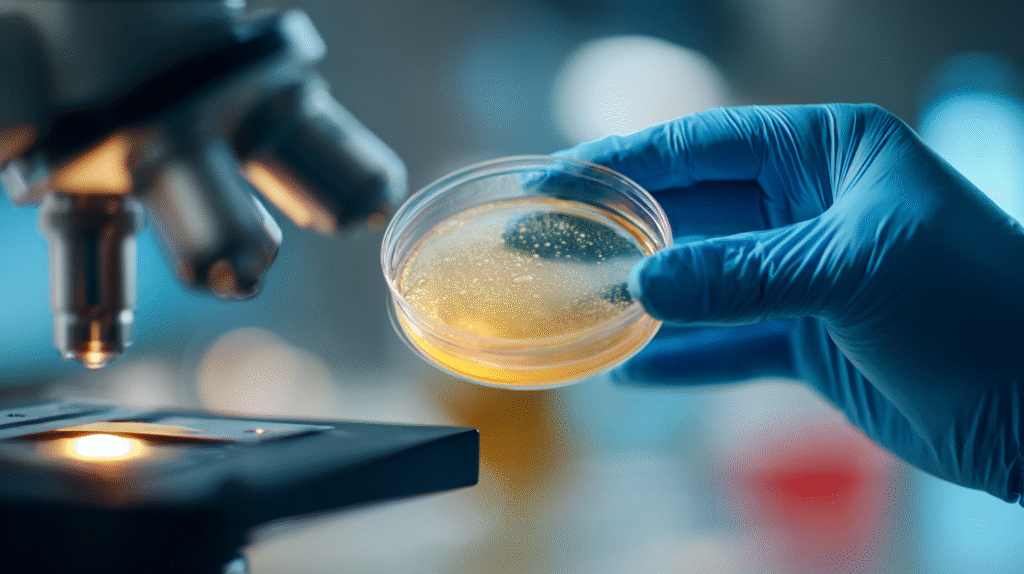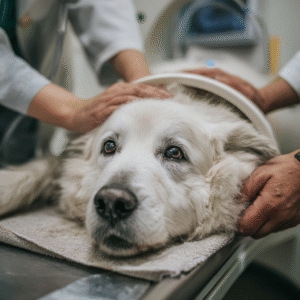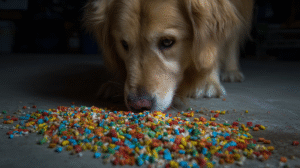Understanding and Managing Crystals in Dog Urine
Discovering that your beloved canine companion has health issues can be worrying for any pet owner.
When your vet mentions finding crystals in dog urine, it’s natural to feel concerned, especially when considering if are crystals in dog urine dangerous.
The presence of dog crystals in urine can sometimes signal an underlying health problem that needs attention.
Fortunately, understanding urinary crystals in dogs is the first step toward effective management and treatment, ensuring your furry friend stays happy and healthy.
Table of Contents
- What Exactly Are Urinary Crystals in Dogs?
- Identifying the Signs: What Do Crystals in Dog Urine Look Like?
- Common Types of Dog Crystals in Urine
- What Causes the Formation of Crystals in Dog Urine?
- A Holistic Approach to Managing Urinary Health with Vitaplus (Vidatox)
- How Vets Diagnose and Treat Crystals in Dog Urine
- Are Crystals in Dog Urine Dangerous? Potential Risks and When to Worry
- Recovery and Long-Term Management for Your Dog
- Frequently Asked Questions About Crystals in Dog Urine
What Exactly Are Urinary Crystals in Dogs?
It might surprise you to learn that finding microscopic crystals in dog urine during a urinalysis (a lab test of a urine sample) is quite common.
Their presence doesn’t automatically mean your dog is sick.
These tiny mineral formations occur when your dog’s urine becomes oversaturated with certain substances.
Think of it like salt crystals forming after seawater evaporates; when mineral concentrations get too high, they solidify.
However, a large quantity of crystals in dog urine or the presence of specific types can be a red flag.
It could point to an underlying issue like a bladder infection, a genetic predisposition, or even dietary imbalances.
The urinary system is a finely tuned machine.
The kidneys filter waste from the blood, which then travels through tubes called ureters to the bladder for storage.
When it’s time to go, urine exits the body through the urethra.
Normal urine maintains a delicate balance of minerals, water, and waste products.
When this balance is disrupted, urinary crystals in dogs can precipitate out of the solution.
If enough of these crystals clump together, they can form bladder stones, which are a much more serious problem causing significant discomfort.
The key takeaway is that while dog crystals in urine aren’t always a crisis, they require careful monitoring and veterinary guidance.
Identifying the Signs: What Do Crystals in Dog Urine Look Like?
You won’t be able to see individual crystals in dog urine with the naked eye. They are microscopic structures that can only be identified by a veterinarian using a microscope.
Instead of seeing the crystals themselves, you are much more likely to notice behavioral changes in your pet.
Symptoms associated with urinary crystals in dogs often include:
- Urinating more often than usual.
- Straining or showing signs of pain during urination.
- Having accidents inside the house.
- Blood appearing in the urine (hematuria).
- Drinking more water than normal.
- Urine that looks cloudy or discolored.
In some rare cases, a very high concentration of crystals in dog urine can create a sandy sediment that might be visible in a collected urine sample. Under a microscope, these crystals have distinct shapes; some look like clear rectangles, while others can resemble hexagons or even starbursts.

Common Types of Dog Crystals in Urine
Veterinarians identify several different types of urinary crystals in dogs, each with different causes and implications.
Struvite Crystals: This is a very common type of crystal often associated with urinary tract infections (UTIs). UTIs can change the urine’s pH level, making it more alkaline and creating the perfect environment for struvite crystals to form.
Calcium Oxalate Crystals: These are another one of the most frequently seen dog crystals in urine. Certain breeds, including Miniature Schnauzers, Bichons Frise, and Yorkshire Terriers, are genetically prone to developing them.
Ammonium Urate Crystals: These are less common and often linked to liver problems, such as a liver shunt, or a specific genetic mutation. Dalmatians are famously predisposed to this type of crystals in dog urine due to how their bodies metabolize uric acid.
Cystine Crystals: This is a rare type that develops in dogs with a hereditary kidney defect. This defect prevents them from properly reabsorbing an amino acid called cystine, leading to crystal formation.
Identifying the specific type of crystals in dog urine is crucial for determining the correct treatment plan.
What Causes the Formation of Crystals in Dog Urine?
The formation of crystals in dog urine is a complex issue influenced by several key factors.
Ultimately, it happens when the urine becomes supersaturated with minerals, and the pH balance is just right for crystallization to occur.
Here are the primary contributors:
- Genetics: As noted, some dog breeds are simply hardwired to be more susceptible to forming urinary crystals in dogs. Their bodies may process certain compounds differently, leading to higher mineral concentrations in their urine.
- Nutrition: Diet plays a massive role. The food your dog eats directly impacts the mineral content and pH of their urine. However, this is also linked to genetics; two dogs eating the same food may have different outcomes, with only the predisposed one developing dog crystals in urine.
- Underlying Medical Conditions: A urinary tract infection is a classic cause, especially for struvite crystals. Other conditions like kidney disease or hormonal disorders can also lead to high levels of calcium in the blood, which can then result in crystals in dog urine.
- Dehydration: When a dog doesn’t drink enough water, their urine becomes more concentrated. This higher concentration of minerals significantly increases the risk of crystal formation.
Understanding these causes helps your veterinarian create a targeted strategy to manage and prevent the recurrence of crystals in dog urine.

A Holistic Approach to Managing Urinary Health with Vitaplus (Vidatox)
When managing conditions like crystals in dog urine, which often involve inflammation and discomfort, many pet owners seek complementary therapies to support their dog’s prescribed veterinary treatment.
One such natural supplement gaining attention is Vitaplus (Vidatox). Derived from the venom of the blue scorpion, this remedy is primarily recognized for its potential in oncology support but also possesses properties that can be beneficial for general wellness, including urinary health.
The presence of urinary crystals in dogs can lead to irritation and inflammation of the bladder lining, causing pain and frequent urination.
The key benefit of Vitaplus (Vidatox) in this context lies in its powerful anti-inflammatory properties.
The peptides found in the formulation may help reduce the inflammation associated with urinary tract irritation caused by dog crystals in urine.
By soothing the bladder lining, it could help alleviate some of the discomfort your dog experiences, making urination less painful.
This contributes to an overall better quality of life while the primary issue of crystals in dog urine is being addressed through diet or medication.
Furthermore, the pain management benefits of Vitaplus (Vidatox) are noteworthy.
Chronic discomfort from urinary issues can make a dog lethargic and unhappy. Vitaplus (Vidatox) may offer a natural way to help manage this pain without the side effects associated with some traditional pain relievers.
While its most studied application is its potential to stop tumor growth by inhibiting angiogenesis (the formation of new blood vessels that feed tumors), the foundational mechanisms—reducing inflammation and managing pain—are applicable to a wider range of health challenges.
Integrating Vitaplus (Vidatox) as part of a holistic management plan, under the guidance of your veterinarian, could provide comprehensive support for your dog’s recovery from issues related to crystals in dog urine.
It offers a way to address the symptoms of inflammation and pain, supporting the body’s natural healing processes.
How Vets Diagnose and Treat Crystals in Dog Urine
If your dog shows signs of urinary trouble, your vet will start by requesting a urine sample.
The best sample is typically the first one of the morning, as it’s the most concentrated. You can collect it using a clean, shallow container or a ladle. For the most accurate results, the sample should be as fresh as possible.
Once at the clinic, a complete urinalysis is performed. This test allows the veterinarian to examine the urine under a microscope to confirm the presence and identify the type of crystals in dog urine.
Treatment for dog crystals in urine almost always involves nutritional therapy. Your vet will likely recommend switching to a special therapeutic diet. These prescription foods are formulated to:
- Dissolve existing urinary crystals in dogs.
- Adjust the urine pH to a level that discourages crystal formation.
- Control mineral content to prevent oversaturation.
In addition to dietary changes, medication may be prescribed. If a UTI is present, antibiotics are essential. Other medications can help alter urine pH or bind to minerals to prevent them from forming crystals in dog urine.

Are Crystals in Dog Urine Dangerous? Potential Risks and When to Worry
This is a critical question for every concerned pet owner. So, are crystals in dog urine dangerous?
The crystals themselves, in small numbers, are not typically dangerous. The real danger arises when the crystals in dog urine aggregate and form larger structures.
When many dog crystals in urine clump together, they can create a sludge-like sediment or, worse, solidify into bladder stones (uroliths).
These stones can irritate the bladder lining, cause chronic pain, and lead to persistent infections. The most life-threatening risk is a urinary blockage. This occurs when a stone becomes lodged in the urethra, completely preventing urination.
A urinary blockage is a medical emergency. Without the ability to urinate, toxins build up in the bloodstream, leading to kidney failure and death if not treated immediately.
If you ever see your dog straining to urinate but producing no urine, seek emergency veterinary care right away. While the answer to “are crystals in dog urine dangerous?” is “not always,” their potential to cause a blockage means they must be taken seriously. Addressing urinary crystals in dogs early is key to preventing these dangerous complications.
Recovery and Long-Term Management for Your Dog
Recovery from crystals in dog urine depends on the crystal type and your dog’s individual health.
Struvite crystals, for instance, can often be completely dissolved by treating the associated UTI and feeding a therapeutic diet. However, many vets recommend keeping the dog on this special diet for life to prevent the recurrence of dog crystals in urine.
Other types, especially those with a genetic basis like calcium oxalate, can be more challenging to manage. The focus becomes lifelong prevention rather than a cure.
It is very common for urinary crystals in dogs to reappear. This is why consistent management is so important. Never stop a prescription diet without first consulting your veterinarian.
During recovery, closely monitor your dog’s urination habits. Any return of symptoms like straining, increased frequency, or bloody urine warrants an immediate vet visit and a new urine sample analysis. Regular check-ups will help ensure the problem of crystals in dog urine remains under control.

Frequently Asked Questions About Crystals in Dog Urine
What food causes crystals in dog urine? No single brand or type of food universally causes crystals in dog urine. The issue is highly individual and depends on a dog’s genetics, metabolism, and urine pH. A diet that is perfectly fine for one dog might contribute to the formation of urinary crystals in dogs in another. Your vet will recommend a specific therapeutic diet based on the type of crystals found.
What pH level causes struvite crystals in dogs? Struvite crystals typically form in alkaline urine, meaning the pH is above 7.0, often between 7.5 and 9.0. This alkaline environment is frequently caused by bacteria from a UTI. Treatment involves both antibiotics to clear the infection and a special diet to lower the urine pH, dissolving the existing dog crystals in urine.
How are crystals in dog urine treated? Treatment is primarily centered around nutritional management with a prescription diet designed to dissolve crystals and prevent new ones from forming. Depending on the cause, your vet may also prescribe medications like antibiotics for infections or other drugs to adjust urine pH. Increasing water intake to keep urine dilute is also a crucial part of the plan.
Are crystals in dog urine dangerous? While the presence of microscopic crystals is not immediately dangerous, they can become a serious problem. The main concern is that crystals in dog urine can clump together to form bladder stones. These stones can cause pain, and infections, and may lead to a life-threatening urinary blockage, which is a medical emergency. Therefore, the potential for danger means that urinary crystals in dogs should always be managed by a veterinarian.




